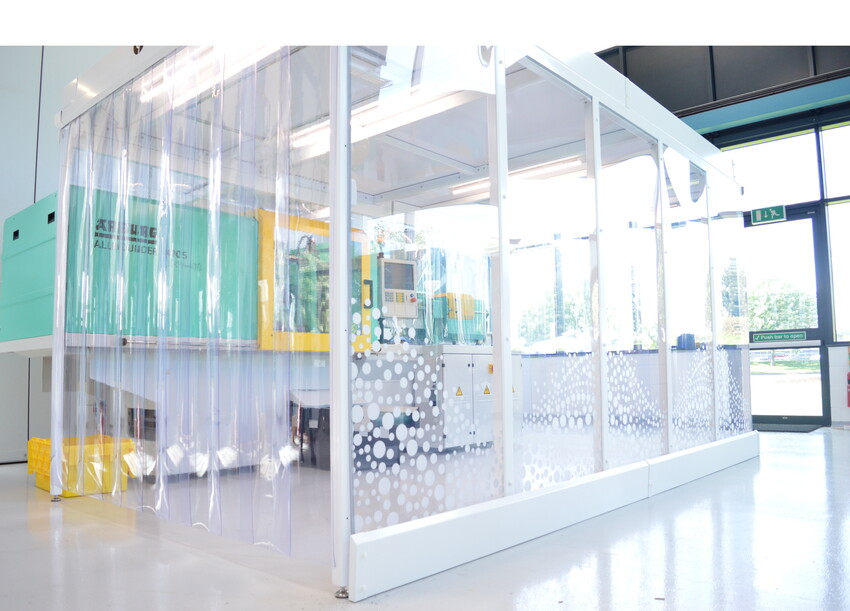Creating a repeatable environment for micro moulding medical device parts.

posted 20th August 2021
For injection moulders, upgrading plastics manufacturing with a cleanroom to gain access to medical markets is a common move and a natural progression pathway. Over the years, Connect 2 Cleanrooms (C2C) has provided modular cleanrooms to support many organisations on this journey, typically providing ISO 14644-1:2015 class 7 cleanrooms. Indeed, C2C provided exactly such an environment for Biplas Medical Ltd, when it introduced clean production, back in 2018.
Micro-moulding
More recently, the technical injection moulder has taken its cleanroom production to another level—partnering with C2C for a second time—when it needed an ISO class 5 cleanroom to house a micro injection moulding machine. This new production setup has been created to help Biplas facilitate an Innovate UK grant project, as it has joined a European consortium to develop a cancer diagnostics device. The consortium is pushing boundaries, as the device in development stands to be produced using the smallest moulding ever made.
The larger parts produced by the micro moulding machine are around three to four grams in weight, but for the Innovate UK grant project, parts are fractions of a gram—even less than 0.1g. These parts are so small that QC inspection requires a microscope and camera.
The cleanroom ISO standard (14644-1:2015) dictates that you are allowed no more than 10,200 particles of size 0.3 micron (µm) in a cubic metre of air within an ISO class 5 cleanroom. To give an idea of scale, human hair is on average 100µm in diameter and smoke particles are 1µm. Achieving a microscopic level of environmental control is even more critical when producing micro parts as any contaminants would completely stop the products from working.
Biplas has also been awarded micro-moulding contracts for dentistry components and a two-shot biotechnology component that separates fluids and cells as they pass through the product. Both parts couldn’t be produced in conditions any higher than ISO class 5. With its ISO 13485 (Medical devices - Quality management systems) accreditation due for completion later this year, Biplas is demonstrating its ability to provide quality medical devices.

Benefits of clean production
A cleanroom creates a reliable and repeatable environment with controlled levels of airborne particulate. For manufacturers, this consistently clean production environment improves yield by reducing the number of parts that are rejected after QC inspection.
For Biplas, the reduction in its scrap rate wasn’t the only way profitability was improved following the introduction of its first cleanroom. Biplas was able to add on packaging services to clients so its scope of supply was increased. Clients also benefitted from this value-added service, as components that are cleanroom packed and double-bagged are not only much easier to transfer into a cleanroom, but they are more reliable.
Often, the biggest contamination risk in a cleanroom is people. Operatives need to be trained to develop skills and knowledge in this specialised area of the market. Once trained, a workforce will be aware of the appropriate behaviours that will control the introduction, generation and retention of particles, in line with ISO 14644 standards.
Cleanroom design for plastics manufacturers
The challenge with creating a clean environment for medical plastics is that moulding machines will produce contaminants during a cycle. A favoured solution is to part-enclose the machine in a clean environment so that the tool face is protected by clean air, but the hopper remains external to the environment. Purpose-built modular cleanrooms can be profiled around machinery, or designed with clean canopies that can be integrated directly with the machine. Canopies with retractable fan filer units can allow tool changing to be a quicker procedure, reducing downtime in production.
It is still possible to achieve a classified environment with full machine coverage. To achieve particle counts according to the levels dictated in ISO 146441, the cleanroom needs to introduce enough clean air to accommodate for the contaminants produced by the process when operational.
Connect 2 Cleanrooms Ltd will be on booth 114 at Medical Technology UK 2022 and are at: Riverside House, Forge Lane, Halton, Lancaster, Lancashire, LA2 6RH
+44(0)1524 812 899
info@connect2cleanrooms.com
Biplas Medical Ltd are at: Unit 3 Llantrisant Business Park, Llantrisant, Pontyclun, RCT, CF72 8LF, South Wales
+44 (0)1443 237654
Interested in visiting Medical Technology UK 2022?
Let us know HERE and we will inform you as soon as registration opens, later this year.
